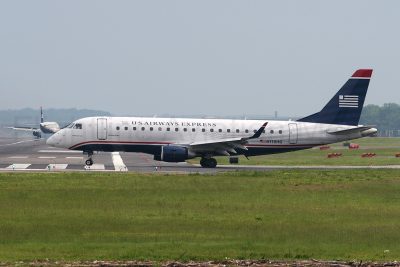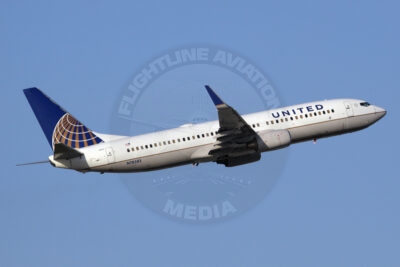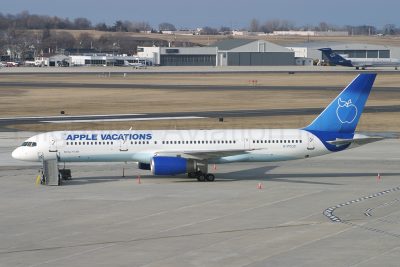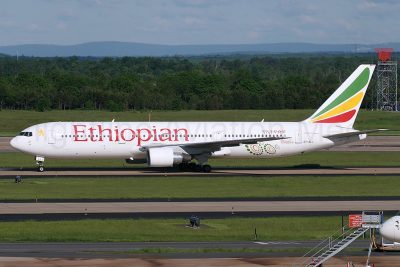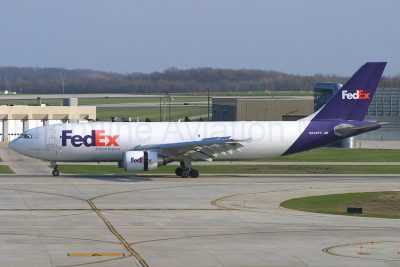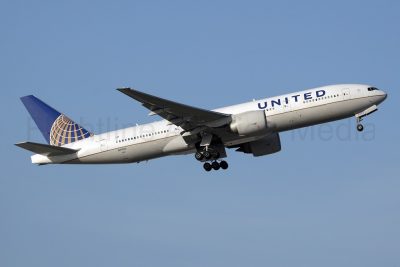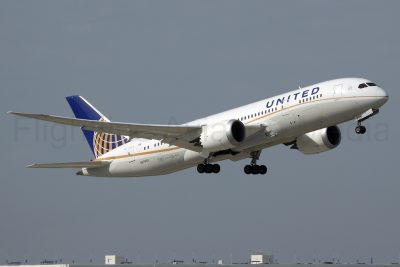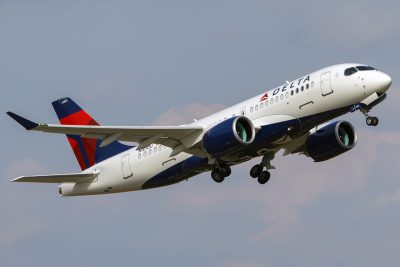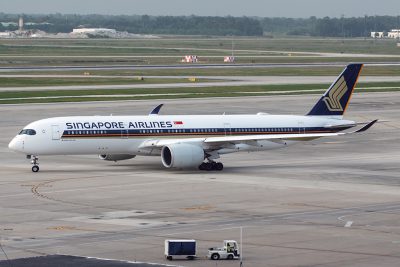2 Engines Under the Wings
The two engine underwing model is the most common type of commercial aircraft in the sky today. There are two types: single-aisle, narrow body (Boeing 737, 757, Airbus A220 & A320, and Embraer E170) and two-aisle widebody (Boeing 767, 777, 787, Airbus A300, A330, and A350). There are photo examples of each type at the bottom of this page. Place your mouse over the highlighted text to see that area on the image to the right.
Background
What to Look For
The most obvious feature by which to identify an A220 is the unique streamlined shape of its nose & cockpit windows. All A220s have winglets, oval shaped cabin windows, and one emergency exit over the wing.
There are two A220 versions: the A220-100 and A220-300. The -300 is longer and will have 17 windows ahead of the emergency exit compared with 12 for the -100 version.

The most obvious feature by which to identify an A220 is the unique streamlined shape of its nose & cockpit windows All A220s have winglets, oval shaped cabin windows, and one emergency exit over the wing.
There are two A220 versions: the A220-100 and A220-300. The -300 is longer and will have 17 windows ahead of the emergency exit compared with 12 for the -100 version.

The most obvious feature by which to identify an A220 is the unique streamlined shape of its nose & cockpit windows. All A220s have winglets, oval shaped cabin windows, and one emergency exit over the wing.
There are two A220 versions: the A220-100 and A220-300. The -300 is longer and will have 17 windows ahead of the emergency exit compared with 12 for the -100 version.

While these planes can be confused with other narrowbody jets from a distance, the one thing that stands out is the shape of the nose. The Embraer jet has a longer and more tapered nose, similar to that of their smaller Regional Jets, the ERJ-135/145.
The most notable visible difference between the E-170/E-175 and E-190 versions is that the 170/175 do not have an emergency exit over the wing because they are shorter, while the 190 has one over wing exit on each side. All Embraer 170 family planes have winglets.
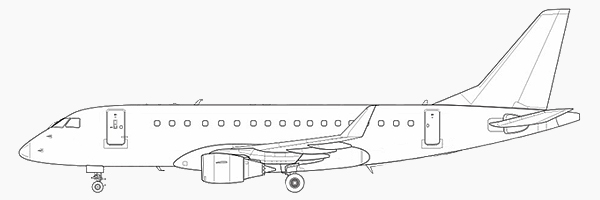
While these planes can be confused with other narrowbody jets from a distance, the one thing that stands out is the shape of the nose. The Embraer jet has a longer and more tapered nose, similar to that of their smaller Regional Jets, the ERJ-135/145.
The most notable visible difference between the E-170/E-175 and E-190 versions is that the 170/175 do not have an emergency exit over the wing because they are shorter, while the 190 has one over wing exit on each side. All Embraer 170 family planes have winglets.

While these planes can be confused with other narrowbody jets from a distance, the one thing that stands out is the shape of the nose. The Embraer jet has a longer and more tapered nose , similar to that of their smaller Regional Jets, the ERJ-135/145.
The most notable visible difference between the E-170/E-175 and E-190 versions is that the 170/175 do not have an emergency exit over the wing because they are shorter, while the 190 has one over wing exit on each side. All Embraer 170 family planes have winglets.

The Boeing 737 compares to the Airbus A320. All 737s have a dorsal fin at the base of the tail that forms an angle where it meets the fuselage, while the Airbus is straight.
The 737 variants that are in service today are the 3rd generation, comprised of the -700, -800, and -900 models, and the 4th generation Max 8 and Max 9. The older generation is rarely seen anymore. Nearly all of the current 737s have winglets, either the blended shape or the scimitar shape, to improve fuel economy by reducing aerodynamic drag.
737-700 models can be identified by a single emergency exit over the wing, while all others have two. The only significant difference between each model is length, with the -700 being the shortest. The main difference between the older models and the 737 Max is the narrow APU outlet under the tail and the Max has larger engines with chevron-shaped exhaust outlets.
When viewed from the front, the 737’s engines are not fully circular but slightly flattened on the bottom to help with ground clearance.




The Boeing 737 compares to the Airbus A320. All 737s have a dorsal fin at the base of the tail that forms an angle where it meets the fuselage, while the Airbus is straight.
The 737 variants that are in service today are the 3rd generation, comprised of the -700, -800, and -900 models, and the 4th generation Max 8 and Max 9. The older generation is rarely seen anymore. Nearly all of the current 737s have winglets, either the blended shape or the scimitar shape, to improve fuel economy by reducing aerodynamic drag.
737-700 models can be identified by a single emergency exit over the wing, while all others have two. The only significant difference between each model is length, with the -700 being the shortest. The main difference between the older models and the 737 Max is the narrow APU outlet under the tail and the Max has larger engines with chevron-shaped exhaust outlets.
When viewed from the front, the 737’s engines are not fully circular but slightly flattened on the bottom to help with ground clearance.




The Boeing 737 compares to the Airbus A320. All 737 models have a dorsal fin at the base of the tail that forms an angle where it meets the fuselage, while the Airbus is straight.
The 737 variants that are in service today are the 3rd generation, comprised of the -700, -800, and -900 models, and the 4th generation Max 8 and Max 9. The older generation is rarely seen anymore. Nearly all of the current 737s have winglets, either the blended shape or the scimitar shape, to improve fuel economy by reducing aerodynamic drag.
737-700 models can be identified by a single emergency exit over the wing, while all others have two. The only significant difference between each model is length, with the -700 being the shortest. The main difference between the older models and the 737 Max is the narrow APU outlet under the tail and the Max has larger engines with chevron-shaped exhaust outlets.
When viewed from the front, the 737’s engines are not fully circular but slightly flattened on the bottom to help with ground clearance.




The A320 family includes the A319, A320, and A321. They are all the same except for length. The A319 has one emergency exit over the wing; the A320 has two; while the longer A321 instead has an exit door in front of and behind the wing for a total of 4 exit doors per side.
The tailcone where the Auxilliary Power Unit exhaust is located on an Airbus jet extends out further and is more tapered than a Boeing 737. In addition, all A320 family aircraft have wingtip extensions called wingtip fences.
The new generation of the A320 models, called A320NEO (New Engine Option) along with A319NEO and A321NEO, can be identified by their much larger engines and sharklets replacing the wingtip fences.

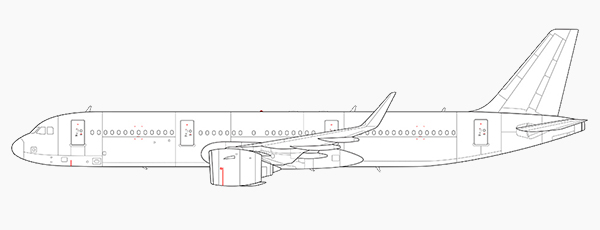
The A320 family includes the A319, A320, and A321. They are all the same except for length. The A319 has one emergency exit over the wing; the A320 has two; while the longer A321 instead has an exit door in front of and behind the wing for a total of 4 exit doors per side.
The tailcone where the Auxilliary Power Unit exhaust is located on an Airbus jet extends out further and is more tapered than a Boeing 737. In addition, all A320 family aircraft have a wingtip extension called a wingtip fence.
The new generation of the A320 models, called A320NEO (New Engine Option) along with A319NEO and A321NEO, can be identified by their much larger engines and sharklets replacing the wingtip fences.


The A320 family includes the A319, A320, and A321. They are all the same except for length. The A319 has one emergency exit over the wing; the A320 has two; while the longer A321 instead has an exit door in front of and behind the wing for a total of 4 exit doors per side.
The tailcone where the Auxilliary Power Unit exhaust is located on an Airbus jet extends out further and is more tapered than a Boeing 737. In addition, all A320 family aircraft have a wingtip extensions called a wingtip fence.
The new generation of the A320 models, called A320NEO (New Engine Option) along with A319NEO and A321NEO, can be identified by their much larger engines and sharklets replacing the wingtip fences.


The Boeing 757 is in the same class as the Airbus A321 in passenger capacity. In actual measurements however, the 757 is 6 feet taller at the tail, 9 feet longer, and has a 13 foot wider wingspan. This gives the 757 a tall appearance compared to other aircraft.
There are only two versions of the 757, the 757-300 being 30 feet longer than a 757-200. All 757s will have 2 emergency exits over the wings; a 757-200 will also have 3 exit doors per side while a 757-300 will have 4 exit doors per side. Also, many airlines retrofitted their 757s with winglets to improve fuel economy similar to the 737 3rd generation above.

The Boeing 757 is in the same class as the Airbus A321 in passenger capacity. In actual measurements however, the 757 is 6 feet taller at the tail, 9 feet longer, and has a 13 foot wider wingspan. This gives the 757 a tall appearance compared to other aircraft.
There are only two versions of the 757, the 757-300 being 30 feet longer than a 757-200. All 757s will have 2 emergency exits over the wings; a 757-200 will also have 3 exit doors per side while a 757-300 will have 4 exit doors per side. Also, many airlines retrofitted their 757s with winglets to improve fuel economy similar to the 737 3rd generation above.

The Boeing 757 is in the same class as the Airbus A321 in passenger capacity. In actual measurements however, the 757 is 6 feet taller at the tail, 9 feet longer, and has a 13 foot wider wingspan. This gives the 757 a tall appearance compared to other aircraft.
There are only two versions of the 757, the 757-300 being 30 feet longer than a 757-200. All 757s will have 2 emergency exits over the wings; a 757-200 will also have 3 exit doors per side while a 757-300 will have 4 exit doors per side. Also, many airlines retrofitted their 757s with winglets to improve fuel economy similar to the 737 3rd generation above.

The Boeing 767 and Airbus A300 (A310 is a shorter version of the A300) are widebody jets and are very similar on the outside. The main difference is the top of the fuselage under the tail slopes down on the 767 but is straight all the way out to the end of the APU on the A300. This design is common on all Airbus aircraft.
Also, on passenger versions of the A300 the windows at the rear appear to slope upward as shown. There are few remaining A300 passenger aircraft in service.


The Boeing 767 and Airbus A300 (A310 is a shorter version of the A300) are widebody jets and are very similar on the outside. The main difference is the top of the fuselage under the tailslopes down on the 767 but is straight all the way out to the end of the APU on the A300. This design is common on all Airbus aircraft.
Also, on passenger versions of the A300 the windows at the rear appear to slope upward as shown. There are few remaining A300 passenger aircraft in service.


The Boeing 767 and Airbus A300 (A310 is a shorter version of the A300) are widebody jets and are very similar on the outside. The main difference is the top of the fuselage under the tail slopes down on the 767 but is straight all the way out to the end of the APU on the A300. This design is common on all Airbus aircraft.
Also, on passenger versions of the A300 the windows at the rear appear to slope upward as shown. There are few remaining A300 passenger aircraft in service.


The Boeing 787 has 3 versions: 787-8, 787-9, and 787-10. The only difference between them is length (and seating capacity inside). The 787-8 looks similar to a 767 and is about the same size, but the major difference is the nose which is a more aerodynamic sloping design. All 787 versions have 4 exit doors per side. Also, the wings on all 787s do not have winglets but they have a well defined upward curvature and the wingtips are more slightly curved upward as well. This improves the plane’s aerodynamics, fuel economy, and range.
The engines on this plane are very large and the rear edge of the exhaust duct has a serrated, chevron pattern identical to the 737 Max and 747-8 which helps reduce noise.

The Boeing 787 has 3 versions: 787-8, 787-9, and 787-10. The only difference between them is length (and seating capacity inside). The 787-8 looks similar to a 767 and is about the same size, but the major difference is the nose which is a more aerodynamic sloping design. All 787 versions have 4 exit doors per side. Also, the wings on all 787s do not have winglets but they have a well defined upward curvature and the wingtips are more slightly curved upward as well. This improves the plane’s aerodynamics, fuel economy, and range.
The engines on this plane are very large and the rear edge of the exhaust duct has a serrated, chevron pattern identical to the 737 Max and 747-8 which helps reduce noise.

The Boeing 787 has 3 versions: 787-8, 787-9, and 787-10. The only difference between them is length (and seating capacity inside). The 787-8 looks similar to a 767 and is about the same size, but the major difference is the nose which is a more aerodynamic sloping design. All 787 versions have 4 exit doors per side. Also, the wings on all 787s do not have winglets but they have a well defined upward curvature and the wingtips are more slightly curved upward as well. This improves the plane’s aerodynamics, fuel economy, and range.
The engines on this plane are very large and the rear edge of the exhaust duct has a serrated, chevron pattern identical to the 737 Max and 747-8 which helps reduce noise.

The A330 is a twin engine version of the 4-engine A340 model and looks very similar to the Boeing 777. As noted above, the top of the Boeing fuselage under the tail curves down while the Airbus is straight, and the window line at the rear of the A330 curves upward. The A330 has winglets while the 777 does not. The tailcone at the end of the 777 fuselage ends in a wedge shape where the APU exhaust is located while the A330 is more cone shaped.
All A330 versions have 4 exit doors per side, while the 777-200 has 4 but the longer 777-300 has an extra emergency exit over the wing.


The A330 is a twin engine version of the 4-engine A340 model and looks very similar to the Boeing 777. As noted above, the top of the Boeing fuselage under the tail curves down while the Airbus is straight, and the window line at the rear of the A330 curves upward. The A330 has winglets while the 777 does not. The tailcone at the end of the 777 fuselage ends in a wedge shape where the APU exhaust is located while the A330 is more cone shaped.
All A330 versions have 4 exit doors per side, while the 777-200 has 4 but the longer 777-300 has an extra emergency exit over the wing.


The A330 is a twin engine version of the 4-engine A340 model and looks very similar to the Boeing 777. As noted above, the top of the Boeing fuselage under the tail curves down while the Airbus is straight, and the window line at the rear of the A330 curves upward. The A330 has winglets while the 777 does not. The tailcone at the end of the 777 fuselage ends in a wedge shape where the APU exhaust is located while the A330 is more cone shaped.
All A330 versions have 4 exit doors per side, while the 777-200 has 4 but the longer 777-300 has an extra emergency exit over the wing.


The Airbus A350 comes in two versions: the A350-900 and the A350-1000, which is 23 feet longer. These aircraft can be distinguished from other Airbus widebody jets by several features. The window line goes straight all the way to the rear door; the cockpit is unique and features windows with rounded corners surrounded by black trim; and unique winglets that curve and sweep back.
All A350s have 4 exit doors per side, and the -900 has 4 wheels on the main landing gear while the -1000 has 6.
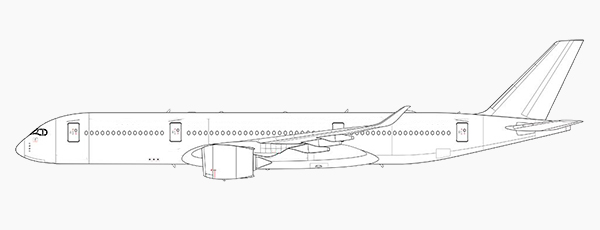
The Airbus A350 comes in two versions: the A350-900 and the A350-1000, which is 23 feet longer. These aircraft can be distinguished from other Airbus widebody jets by several features. The window line goes straight all the way to the rear door; the cockpit is unique and features windows with rounded corners surrounded by black trim; and unique winglets that curve and sweep back.
All A350s have 4 exit doors per side, and the -900 has 4 wheels on the main landing gear while the -1000 has 6.

The Airbus A350 comes in two versions: the A350-900 and the A350-1000, which is 23 feet longer. These aircraft can be distinguished from other Airbus widebody jets by several features. The window line goes straight all the way to the rear door; the cockpit is unique and features windows with rounded corners surrounded by black trim; and unique winglets that curve and sweep back.
All A350s have 4 exit doors per side, and the -900 has 4 wheels on the main landing gear while the -1000 has 6.



